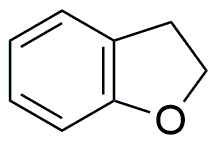2,3-Dihydrobenzofuran is widely utilized in research focused on:
- Pharmaceutical Development: This compound serves as a key intermediate in the synthesis of various pharmaceuticals, particularly those targeting neurological disorders. Its unique structure allows for modifications that can enhance therapeutic efficacy.
- Organic Synthesis: It is frequently employed in organic chemistry as a building block for creating more complex molecules. Researchers appreciate its versatility, making it a valuable asset in developing new compounds.
- Material Science: 2,3-Dihydrobenzofuran is used in the production of specialty polymers and resins. These materials often exhibit improved thermal stability and mechanical properties, making them suitable for high-performance applications.
- Aromatherapy and Fragrance Industry: Due to its pleasant aromatic profile, this compound is incorporated into perfumes and scented products, offering a unique scent that can enhance consumer appeal.
- Research in Environmental Chemistry: It is studied for its potential applications in environmental remediation, particularly in the degradation of pollutants. Its reactivity can be harnessed to develop methods for cleaning up contaminated sites.
General Information
Properties
Safety and Regulations
Applications
2,3-Dihydrobenzofuran is widely utilized in research focused on:
- Pharmaceutical Development: This compound serves as a key intermediate in the synthesis of various pharmaceuticals, particularly those targeting neurological disorders. Its unique structure allows for modifications that can enhance therapeutic efficacy.
- Organic Synthesis: It is frequently employed in organic chemistry as a building block for creating more complex molecules. Researchers appreciate its versatility, making it a valuable asset in developing new compounds.
- Material Science: 2,3-Dihydrobenzofuran is used in the production of specialty polymers and resins. These materials often exhibit improved thermal stability and mechanical properties, making them suitable for high-performance applications.
- Aromatherapy and Fragrance Industry: Due to its pleasant aromatic profile, this compound is incorporated into perfumes and scented products, offering a unique scent that can enhance consumer appeal.
- Research in Environmental Chemistry: It is studied for its potential applications in environmental remediation, particularly in the degradation of pollutants. Its reactivity can be harnessed to develop methods for cleaning up contaminated sites.
Documents
Safety Data Sheets (SDS)
The SDS provides comprehensive safety information on handling, storage, and disposal of the product.
Product Specification (PS)
The PS provides a comprehensive breakdown of the product’s properties, including chemical composition, physical state, purity, and storage requirements. It also details acceptable quality ranges and the product's intended applications.
Certificates of Analysis (COA)
Search for Certificates of Analysis (COA) by entering the products Lot Number. Lot and Batch Numbers can be found on a product’s label following the words ‘Lot’ or ‘Batch’.
*Catalog Number
*Lot Number
Certificates Of Origin (COO)
This COO confirms the country where the product was manufactured, and also details the materials and components used in it and whether it is derived from natural, synthetic, or other specific sources. This certificate may be required for customs, trade, and regulatory compliance.
*Catalog Number
*Lot Number
Safety Data Sheets (SDS)
The SDS provides comprehensive safety information on handling, storage, and disposal of the product.
DownloadProduct Specification (PS)
The PS provides a comprehensive breakdown of the product’s properties, including chemical composition, physical state, purity, and storage requirements. It also details acceptable quality ranges and the product's intended applications.
DownloadCertificates of Analysis (COA)
Search for Certificates of Analysis (COA) by entering the products Lot Number. Lot and Batch Numbers can be found on a product’s label following the words ‘Lot’ or ‘Batch’.
*Catalog Number
*Lot Number
Certificates Of Origin (COO)
This COO confirms the country where the product was manufactured, and also details the materials and components used in it and whether it is derived from natural, synthetic, or other specific sources. This certificate may be required for customs, trade, and regulatory compliance.


